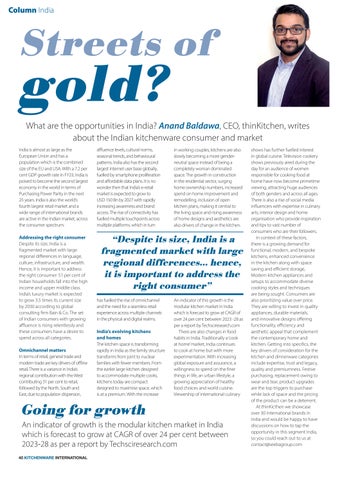Column India
Streets of
gold?
What are the opportunities in India? Anand Baldawa, CEO, thinKitchen, writes about the Indian kitchenware consumer and market India is almost as large as the European Union and has a population which is the combined size of the EU and USA. With a 7.2 per cent GDP growth rate in FY23, India is poised to become the second largest economy in the world in terms of Purchasing Power Parity in the next 25 years. India is also the world’s fourth largest retail market and a wide range of international brands are active in the Indian market, across the consumer spectrum. Addressing the right consumer Despite its size, India is a fragmented market with large regional differences in language, culture, infrastructure, and wealth. Hence, it is important to address the right consumer: 51 per cent of Indian households fall into the high income and upper middle class. India’s luxury market is expected to grow 3.5 times its current size by 2030 according to global consulting firm Bain & Co. The set of Indian consumers with growing affluence is rising relentlessly and these consumers have a desire to spend across all categories. Omnichannel matters In terms of retail, general trade and modern trade are key drivers of offline retail. There is a variance in India’s regional contribution with the West contributing 31 per cent to retail, followed by the North, South and East, due to population dispersion,
affluence levels, cultural norms, seasonal trends, and behavioural patterns. India also has the second largest internet user base globally, fuelled by smartphone proliferation and affordable data plans. It is no wonder then that India’s e-retail market is expected to grow to USD 150 Bn by 2027 with rapidly increasing awareness and brand access. The rise of connectivity has fuelled multiple touchpoints across multiple platforms. which in turn
in working couples, kitchens are also slowly becoming a more genderneutral space instead of being a completely woman dominated space. The growth in construction in the residential sector, surging home ownership numbers, increased spend on home improvement and remodelling, inclusion of open kitchen plans, making it central to the living space and rising awareness of home designs and aesthetics are also drivers of change in the kitchen.
“Despite its size, India is a fragmented market with large regional differences… hence, it is important to address the right consumer” has fuelled the rise of omnichannel and the need for a seamless retail experience across multiple channels in the physical and digital realms. India’s evolving kitchens and homes The kitchen space is transforming rapidly in India as the family structure transforms from joint to nuclear families with fewer members. From the earlier large kitchen designed to accommodate multiple cooks, kitchens today are compact designed to maximise space, which is at a premium. With the increase
An indicator of this growth is the modular kitchen market in India which is forecast to grow at CAGR of over 24 per cent between 2023 -28 as per a report by Techsciresearch.com There are also changes in food habits in India. Traditionally a ‘cook at home’ market, India continues to cook at home but with more experimentation. With increasing global exposure and assurance, a willingness to spend on the finer things in life, an urban lifestyle, a growing appreciation of healthy food choices and world cuisine. Viewership of international culinary
Going for growth An indicator of growth is the modular kitchen market in India which is forecast to grow at CAGR of over 24 per cent between 2023-28 as per a report by Techsciresearch.com 40 KITCHENWARE INTERNATIONAL
shows has further fuelled interest in global cuisine. Television cookery shows previously aired during the day for an audience of women responsible for cooking food at home have now become primetime viewing, attracting huge audiences of both genders and across all ages. There is also a rise of social media influencers with expertise in culinary arts, interior design and home organisation who provide inspiration and tips to vast number of consumers who are their followers. In context of these factors, there is a growing demand for functional, modern, and bespoke kitchens, enhanced convenience in the kitchen along with space saving and efficient storage, Modern kitchen appliances and setups to accommodate diverse cooking styles and techniques are being sought. Consumers are also prioritizing value over price. They are willing to invest in quality appliances, durable materials, and innovative designs offering functionality, efficiency and aesthetic appeal that complement the contemporary home and kitchen. Getting into specifics, the key drivers of consideration for the kitchen and dinnerware categories include expertise, trust and legacy, quality and premiumness. Festive purchasing, replacement owing to wear and tear, product upgrades are the top triggers to purchase while lack of space and the pricing of the product can be a deterrent. At thinKicthen we showcase over 30 international brands in India and would be happy to have discussions on how to tap the opportunity in this segment India, so you could reach out to us at contact@seebagroup.com
